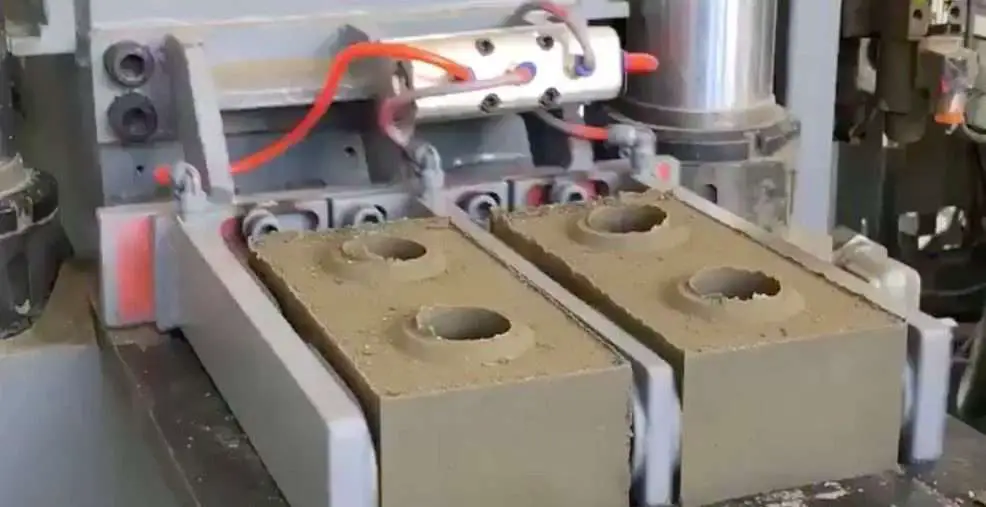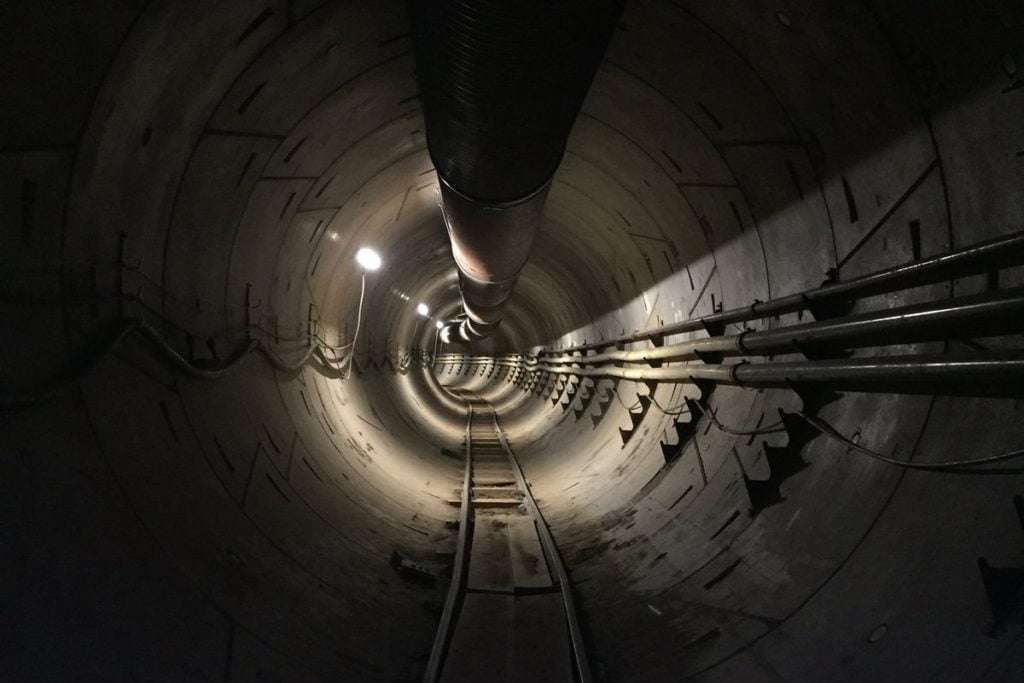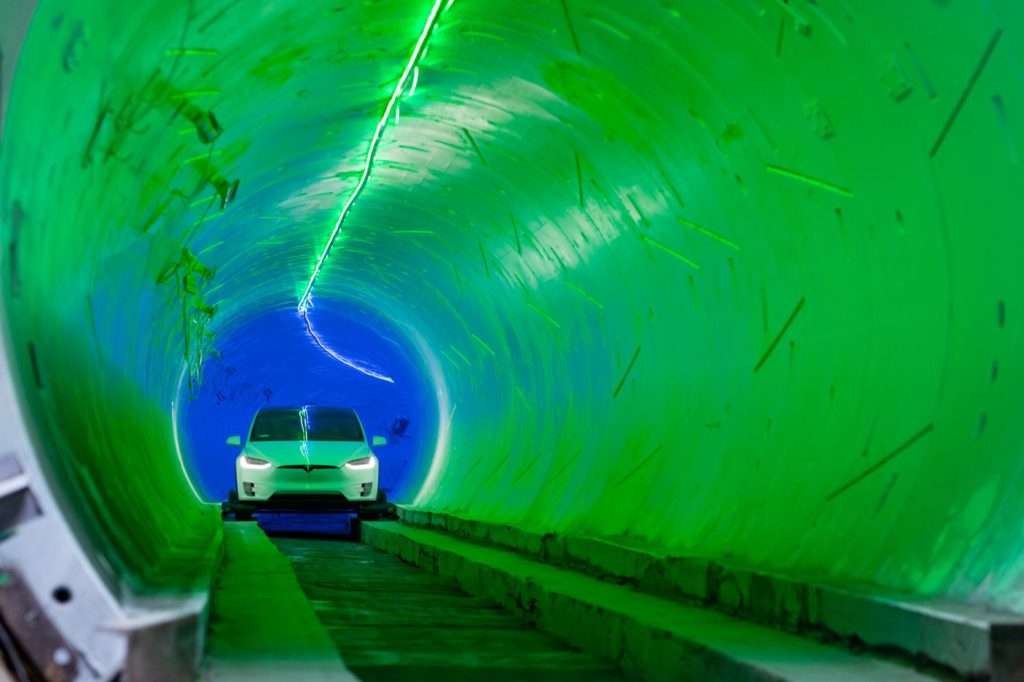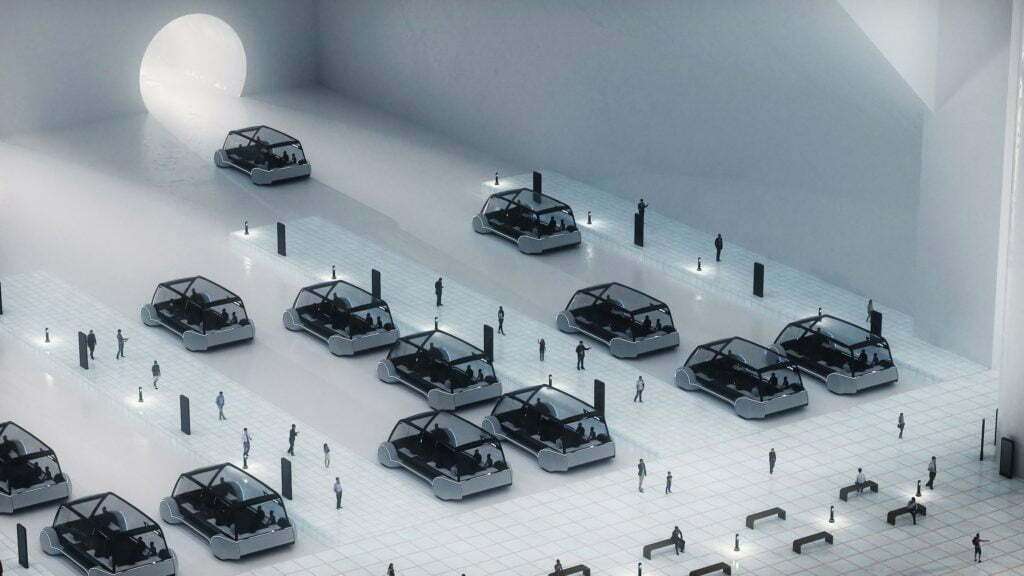Elon Musk is known for his electric cars, recyclable rockets, and satellites that transmit incredible internet speeds to distant locations. In 2016 he began to shift his aim downwards. The idea was to establish a corporation that would address traffic congestion by constructing a network of subterranean tunnels.
Musk was motivated by the notable traffic issues in Los Angeles and the constraints of the present two-dimensional transit system. The Boring Company began as a SpaceX subsidiary before separating and becoming an autonomous corporation in 2018.
History of the Boring Company

In December 2016, Elon Musk proposed the creation of The Boring Company. Since no official permissions were required, in February 2017 the firm began constructing a testing tunnel measuring 15 feet deep, 50 feet long, and 30 feet wide on the grounds of SpaceX’s facilities in Hawthorne. Employees told Elon on a Friday evening that doing so would require approximately 14 days to move personnel vehicles out of the parking area and dig down the first trench with the TBC tunneling machine.
Elon Musk indicated on March 2017 that the business would utilize a tunnel boring machine (TBM) to drill a useable trench at SpaceX the following month. The TBM with The Boring Company’s logo on the side was sighted at SpaceX at the end of April. In May of 2017, The Boring Machine’s name was introduced as Godot, named after the Beckett masterpiece ‘Waiting for Godot’.
According to Musk, the first transit line will travel to Culver City from Los Angeles Airport, with routes to Santa Monica and Westwood next on the list. Elon Musk claims that the tunnel ride will take only five minutes, in contrast to the 45 minutes it takes to travel to Westwood from LAX in regular traffic. These trips are taken in a vehicle traveling 120 mph through a tunnel on an electric sled.
Tunnel Application
The Boring Company submitted a permission request to Los Angeles government inspectors in November 2017. The application requested permission to build a tunnel to Westwood from Hawthorne along Interstate 405. The project was never completed.
A second idea incorporating a Hyperloop, which comprised of a sealed tube going underground to Washington D.C. from New York City, was unveiled around the same time as the Los Angeles tunnel system. The Hyperloop would take only 29 minutes to go from one central city to another, according to Musk. Additional Hyperloop plans include a loop from Los Angeles from San Francisco, and another loop in Texas.
Musk posted a clip in July 2017 showing a test launch of a concept vehicle elevator. In October, Musk disclosed the name of the second TBM: Line-storm. It was named after “A Line-Storm Song” by Robert Frost. Elon Musk indicated in March 2018 that the business would change its strategy to favor walkers and bikes above vehicles, with cars being considered only after all other personalized mass transportation demands had been addressed.
The Boring Company was split off of SpaceX in early 2018 as a distinct business organization, with less than 10% of shares going to early workers and over 90% going to Elon Musk. Following concerns from SpaceX stockholders, The Boring Company reallocated 6% of its ownership to SpaceX in December 2018.
The Hawthorne Tunnel

The Boring Company updated the public on the condition of their product and technology range as they inaugurated their first Hawthorne tunnel. It was one mile long and made with funds from the $113 million they generated internally in 2018. The Boring Company in July 2019 approved the very first external investment, selling $120 shares of stock to a variety of venture capitalists.
After managing operations for Musk for three years, Steve Davis was elected as the president of The Boring Company in November 2019. Davis joined SpaceX in 2003 as one of the company’s first employee. He holds a postgraduate degree in aerospace engineering and particle physics. The company acquired office towers inside a 14 acre industrial district north of Austin, around 16 miles north from where Tesla is constructing its Giga-factory.
The Boring Company Products
The Boring Company is an expert in a variety of niches, one of them being the unique bricks it creates.
The Brick

Over the previous year, Elon Musk has sent out some bizarre and incredible statements, but it turns out he wasn’t kidding about the bricks. Per the public records acquired by TechCrunch, Musk founded The Brick Store LLC to manufacture and distribute bricks.
As The Boring Company pioneers new burrowing and transportation techniques, the bricks will be created from soil removed by tunnel-boring machines. The bricks will cost as little as ten cents per brick and could even be distributed to low-income housing complexes
Tunnel Creation: Reason Behind the Idea and It’s Benefits
Let’s discuss three reasons why Musk thought of creating an improved tunneling technique.
- Musk wants to overcome the problem of ever-increasing traffic on our roads. Today’s public routes include expensive and time-consuming 3D elevated model freeways and circular intersections. In contrast, underground systems are also three-dimensional but enable cost-effective transport. As a result, congestion and traffic would be a relic of the past.
- Musk would like to enhance the appearance of our communities. Existing transport systems take up a significant amount of space in areas where land is limited. Tunnels save space on the surface and have the potential to shift major transit networks underground. We can convert roadways into places that improve society by taking transport underneath.
Musk is looking to create hyperloops that provide transit at higher speeds. This makes hyperloops superior to other existing options.
Advantages of the Tunnel Network:
- Tunnel networks offer infinite capacity. Since the number of tunnels and levels that can be created has no realistic limitations, almost any capacity goal could be met. When compared to the difficulty of adding lanes to a road on the surface, the versatility of an underground system is quite evident.
- Tunnels make the most efficient use of valuable surface land. They also don’t interfere with existing transit infrastructure like roads and walkways.
- Rainfall, snowfall, surface temperatures, and wind do not affect the system’s performance.
- Surface vibration and noise are minimal. Tunnel construction and operation produce no perceptible noise, and the activities are undetected because they remain unseen.
- Tunnel networks allow for future growth. An underground passageway network is considerably easier to expand than one above ground.
Tunnel construction is currently very costly, with several ventures ranging from $1 billion to $100 million per mile. Tunneling prices must be cut by approximately 90% in order to make large tunnel networks affordable. The Boring Company’s Loop tunnels are doing precisely that, now costing around $10 million per mile.
Other Products In Development
Apart from bricks, The Boring Company provides four different tunneling network solutions. Let’s discuss utility, loop, pedestrian, and freight.
UTILITY

Utility allows for easy access to a variety of services without causing any surface modification. A tunnel with a 12-foot diameter includes features like a level maintenance area, lighting systems, video surveillance system, construction engineering, ecological evaluation, and permits. The lengths are adjustable, ranging from 0.25 mile to infinity.
LOOP

A loop is a mass transit network that runs underground. Loops with a 12-foot diameter also include LED Lighting, driving surface, standby power lighting, video recording system, protected wireless communication, mobile phone service, blue light stations, fire safety framework, ventilation system, environmental review, project engineering, and licensing. Possible lengths range from 0.25 mile to infinity with a minimum two-station requirement.
Pedestrian Tunnels

The purpose behind pedestrian tunnels is to provide cyclists and pedestrians with a safeguarded tunnel network free from traffic issues. The length limitation ranges from a minimum of 100 feet up to a maximum of 2,500 feet.
Freight

The Freight includes similar features as the loop and utility product offering, but the purpose is to transport freight underground. The lengths for this are also infinite, with the minimum being 0.25 mile.
GOALS OF THE BORING COMPANY
The objective of The Boring Company is to increase tunneling speeds to the point where creating a tunnel system is financially possible. According to the company, upcoming plans include a “contemporaneous operation” of boring and trench reinforcement to cut tunneling costs and reduce size of the tunnel. Other plans include reusing land and soil for construction operations and other technical advancements.
Scrubbers and several other basic items might be used to compact everything into a smaller tunnel size. This lowers the cost considerably—the entire paradigm of how tunnels work shifts with the vision of this corporation. Musk also intimated that the subsurface infrastructural technology might be employed in his quest to build a self-sustaining civilization.
According to SpaceX committee member Steve Jurvetson, tunnels developed expressly for electric cars are smaller in size, difficulty, and cost. The Boring Company believes that if society adopts electric cars in tunnels as their sole mode of transportation, they won’t need to worry about carbon dioxide or other vehicle emission pollutants.
KEY TAKEAWAYS
The Boring Company is a futuristic company that aims to build underground tunneling networks that will assist the public in commuting safely. Since the company’s creation, there have been numerous innovations, and it aims to refine its processes further in order to make effective transportation methods for the world.
Related Reading: What is Plaid? The Fintech Company Enabling Next Generation of Banking